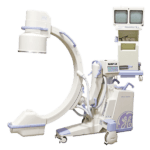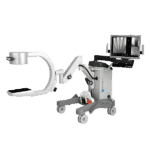A C-Arm system is an overhead x-ray that provides real-time detailed viewing of anatomic structures using fluoroscopic dyes
A C-arm system is an overhead x-ray image intensifier that provides real-time detailed viewing of anatomic structures using fluoroscopic dyes. The system is a non-invasive device that does not enter the patient’s body, making it safe for screening before, during and after procedures.
These machines are mobile, easily transportable, and can be used in confined spaces. The unit’s support structure is shaped like the letter “C”, and is capable of being adjusted to different settings based on the application. The special arced semi-circular design also permits the physician to rotate and angle an x-ray tube without moving the patient. Furthermore, using a moveable C-arm table allows the physician the opportunity to “tilt” the patient while rotating the C-arm system, maximizing the viewing capacity. The flexibility allows physicians to quickly view and monitor the placement of devices like pacemakers, catheters and prostheses.
The C-arm system works in conjunction with patient tables and are specifically designed for x-ray imaging, allowing free positioning of the C-arm around the patient. Tables may even be designed to move and rotate to allow better patient access for procedures and to aid imaging angles.
Though the C-arm system has radiographic capabilities, they are primarily used for fluoroscopic imaging during surgical, orthopedic, critical care, pain management, and emergency care procedures.
Outpatient studies
C-arm system imaging is used for various studies including those of the digestive, reproductive, coronary and venous systems to help identify potential health problems such as stomach ulcers, infertility, and coronary artery occlusion.
Line placement
C-arm fluoroscopes are ideal for use in visually guiding physicians to place needles, stents and catheters in specific areas.
Image Intensifiers
Image intensifiers are usually set up for two purposes: for plain fluoroscopy or digital subtraction angiography (DSA). Image intensifiers are frequently used in orthopedics to help put hardware needed to stabilize bones and joints; for vascular and neurological imaging to ensure surrounding tissues remain healthy; and to help guide surgeons operating on delicate areas such as the spine.
Surgery
The C-Arm Machine has a number of surgical uses including real-time viewing of the gallbladder, liver, heart and bone structures. It can also provide viewing assistance to ensure accuracy during surgery. Some imaging systems are capable of taking images in multiple planes, which is useful for reconstructing a 3D volume of the patient anatomy. This is typically used for surgical navigation. Surgeons also find this helpful to check the placement of implanted devices in the patient.
Pain Management
Image intensifiers are used to help direct needle placement into joints when injecting anesthetics. Pain-relieving medication can be inserted into shoulders and knees with little or no damage to the nearby structures.
C-Arm Components
The portable C-Arm system generally consists of these main components: the x-ray generator, imaging system, and workstation unit.
X-Ray Generator
The X-ray generator, dose control system and collimator controls are usually housed in the frame on which the C-arm is mounted. All of the control systems are directed by the master controller (found in work station). User controls on the C-arm allow the operator to modify the operation of the system while in use. There are several benefits for increased x-ray power. For starters, it allows greater flexibility for imaging while reducing exposure times and the risk for error. These benefits may be very important for pediatric and obese patients who may find longer exposure times daunting.
Get Started
Request Pricing Today!
We’re here to help! Simply fill out the form to tell us a bit about your project. We’ll contact you to set up a conversation so we can discuss how we can best meet your needs. Thank you for considering us!
Great support & services
Save time and energy
Peace of mind
Risk reduction
Types of X-Ray Tubes
The two types of X-ray tubes are fixed anode or rotating anode. Typical features of fixed anode tubes include a heat capacity load 30,000 – 50,000 heat units; an angle on the anode target of about 12 degrees; and single or dual focused anode with 0.5 by 0.5 mm focal spot for fluoroscopic applications and 1.8 by 1.8 mm focal spot size for radiographic applications. Typical features of rotating anode tubes include a 0.3 mm focal spot for better image detail; longer tube life; typical anode heat rating of 300 000 heat units for longer exposure times; and housing with a heat storage limitation of about 1200-1250kHU.
Imaging System
The imaging system unit can perform a variety of movements that allow for use in a variety of surgical procedures such as cardiology, orthopedics and urology. This unit provides the correct structure to properly mount an image intensifier and an X-ray tube. The imaging system must be compact and lightweight to allow easy positioning with a wide range of motion and adequate space to work around, but must still remain firm enough to avoid misalignment.
Workstation unit
Much of the operation of the machine comes from the workstation unit. This unit is typically equipped with the following features: various handles for movement and positioning; power switch and exposure switch; cable hanger; brake pedal; controls for radiographic and fluoroscopic settings; assorted interconnect cables; hard disk and optical disk writer/rewriter, DVD R/RW, PACS system connection; advanced image quality enhancement software such as noise reduction and zoom control; ability to save and swap images; contrast and brightness controls; single or dual large monitors; and advanced image processing such as noise reduction.
Retrofitting in the Digital Age
An issue affecting C-arms today concerns the ability of practitioners to replace their analog equipment with digital devices. In the digital age, analog equipment is essentially being phased out. However, buying new digital equipment is typically very expensive and time-consuming.
There is a solution for C-arms however: the Digital Retrofit for OEC 9800 Series C-Arms. This flat panel digital detector easily upgrades OEC 9800 C-Arms to digital at a fraction of the cost of a new device. More information can be found here.
If you need any assistance in purchasing a C-arm system, please don’t hesitate to contact me.
Posted by:
John Brant (JB)
Sales Manager



